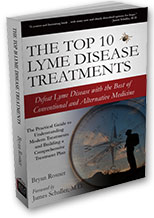|

Author Ken Singleton, M.D.
Excerpts from the Lyme Disease Solution:
Table
of Contents
Introduction
Chapter 1
Chapter 2
Chapter
3
Chapter 4
Chapter 5
Chapter 6
Chapter 7
Chapter 8
Chapter 9
Index
See our complete selection
of Lyme disease books and DVDs.
Customers who purchased The Lyme Disease Solution also
purchased the following book:

The Top 10 Lyme Disease
Treatments by Bryan Rosner
|
|
Paperback Book, 523 Pages, $29.95

Patients and doctors alike face an enormous challenge regarding the diagnosis and treatment of Lyme and other tick-borne illnesses. In this chapter, I want to discuss one very important aspect of this challenge—the recognition of symptoms of Lyme and of the co-infections (other organisms) that may accompany Lyme at the time of Lyme infection.
First of all, let me define two terms. “Symptoms” are subjective feelings as a patient experiences them. For example, knee pain is a symptom of discomfort in the knee as a person experiences it. “Signs” are objective evidences that a doctor examines, observes, or tests for, that allow the doctor to reliably make a diagnosis. For example, a swollen and red knee is a sign of joint inflammation that is called arthritis.
One of the most challenging problems with Lyme disease is that very often neither a patient’s subjective symptoms nor a doctor’s objective signs are specific enough to reliably diagnose Lyme or the co-infections. Unfortunately, when a patient comes to a doctor’s office, there are very few symptoms that are absolutely specific for Lyme. Likewise, there are very few objective signs that a doctor can examine or test for that are so specific that no one disputes the diagnosis of Lyme disease.
The only indisputable Lyme symptom and sign is the presence of a rash that is diagnosed as the erythema migrans (EM) rash. Therefore, if a person does not have a diagnosed EM rash, there is a good possibility that the Lyme diagnosis will be missed. Consequently, those patients can become chronically ill with Lyme disease.
The symptoms of chronic Lyme are often non-specific symptoms that look like a wide variety of other medical conditions. A good example would be the symptom of chronic fatigue. While fatigue is a universal chronic Lyme disease symptom, it is also a major symptom of literally hundreds of other medical conditions, including depression, cancer, heart disease, hypothyroidism (low thyroid function), and chronic stress to name just a few.
In this chapter, I will discuss the symptom patterns of Lyme disease and the major co-infections that often accompany Lyme. The symptoms presented below should not be considered a complete or exhaustive list.
Lyme
and Neurological Disease
Lyme
disease is also frequently the cause or a significant contributing
co-factor in a number of chronic degenerative and neurological diseases,
such as Parkinson’s, Lou Gehrig’s disease (ALS), Alzheimer’s
disease, and multiple sclerosis (MS). In addition, these same conditions
can also be misdiagnosed as a result of Lyme disease, meaning that
physicians can fail to detect that Lyme is the underlying cause.
Susan’s case illustrates what can result when this happens.
Susan came to our office because of neurological symptoms that began six
years previously. An avid gardener living in rural Delaware, she
recalled feeling tired and unmotivated during that summer six years ago.
She recalled no tick bite or rash. In addition to ongoing severe
fatigue, a few months later she began having vision problems and strange
electrical sensations involving her back, legs, and feet. Next, her
knees and leg muscles began to ache, and she began to have night sweats.
This was followed by balance and walking problems shortly
afterwards.
Susan’s doctor appropriately referred her to a neurologist. She
underwent extensive testing—including MRIs, a Lyme screening test, and
lumbar puncture (spinal tap)—all of which were normal. The conclusion
was that she had “atypical multiple sclerosis.” However, the
treatment Susan was prescribed caused her symptoms to become even worse.
One of her friends who had been diagnosed and treated for Lyme convinced
her to get a second opinion concerning Lyme disease. Our laboratory
tests confirmed that Susan had both disseminated Lyme disease and the
co-infection, Babesia. (I will discuss this organism below.)
We treated the Babesia first, using atovaquone and azithromycin. This
was followed by treatment for Lyme disease with intravenous ceftriaxone,
along with oral clarithromycin and metronidazole. (This combination is
used to attack Lyme in its three different structures: spirochete form,
“L” form, and “cystic” form.) After a total of several months of
antibiotic treatment, combined with the natural therapies you will learn
about later in this book, Susan’s symptoms completely resolved.
Lyme and Psychological Disease
A
variety of mental and emotional (psychiatric) conditions can also be
caused or severely exacerbated by Lyme disease. It is estimated that 50
percent of Lyme patients have psychiatric manifestations. These include
behavioral disorders (including impulsive acts of aggression and
violence), bipolar disorder (manic depression), chronic depression,
dementia, eating disorders, hallucinations, mood swings, panic attacks,
paranoia, schizophrenia, and other personality disorders and even
suicide. Jill was one patient who suffered serious psychological
problems because of Lyme.
Before she came to me for treatment, Jill had been in and out of
psychiatric hospitals, where she was treated unsuccessfully for suicidal
depression. Her deteriorating mental and emotional state first began
shortly after she gave birth to her child. Initially, she experienced
what she thought were symptoms of the flu. But soon thereafter, she
began her mental and emotional decline. She was told she had severe
post-partum depression, but her doctors were unable to help her. After
she was properly diagnosed with Lyme disease and was treated with
intravenous and oral antibiotics, she made a remarkable recovery and
received her life back.
Dr. Virginia Sherr is a psychiatrist practicing in Holland,
Pennsylvania. She has published numerous articles in medical journals on
Lyme disease and is an authority on the psychological manifestations of
Lyme disease. She recently reported in the Journal of Psychiatric
Practice three cases of panic disorder that were actually psychiatric
manifestations of Lyme disease. In each of the cases, the patients
presented to her with body symptoms that were not typical of primary
panic disorder alone. These symptoms included foggy thinking and memory
loss; joint pains; light and sound sensitivity; and bizarre, shifting,
and even excruciating nerve pain. She was able to recognize that some
other systemic disorder was occurring in each of these patients. After
the appropriate diagnoses of Lyme disease (and co-infections) were made
and treatment completed, the panic symptoms of each of the patients were
totally eliminated.
Lyme and Heart Disease
One
of the little known facts about Lyme disease is that it can cause a
number of serious cardiovascular problems that can lead to or worsen
heart disease. The reason for this is that, as Lyme disease spreads
through the body, weakening other body systems, it can create an ongoing
strain on the heart and overall cardiovascular system. Left unchecked,
Lyme disease can also cause permanent damage to the heart and even death
by heart attack.
Dr. Phillip W. Paparone, an infectious diseases specialist in New
Jersey, is an expert on heart problems as they relate to Lyme
disease. According to Dr. Paparone, “The potentially fatal cardiac
involvement of Lyme disease remains the least well-documented
complication of this multi-system illness.” Medical research published
in 1990 indicates that between 8 and 10 percent of all Lyme disease
patients have symptoms that indicate heart involvement. He believes that
the percentage of heart disease patients with Lyme disease may actually
be higher due to how easily Lyme disease can escape detection or be
misdiagnosed. For this reason, Dr. Paparone recommends that all patients
suffering from symptoms of heart disease who live in geographic regions
where Lyme disease is most prevalent be screened for the Bb bacteria.
Frederick’s case dramatically illustrates what can happen when Lyme
screening does not take place.
Frederick began noticing peculiar symptoms at the age of thirty-eight.
His feet began swelling, he suffered from shortness of breath with
minimal exertion, and at times he would awaken in the middle of the
night gasping for air. His worsening symptoms motivated him to visit his
family doctor. The doctor sent him for a chest X-ray and immediately
recognized that Frederick was having serious heart problems.
He was referred to a cardiologist (heart specialist) who discovered that
he had “congestive heart failure.” This is a condition in which the
heart muscle becomes weakened to the point that it cannot pump out
enough blood to meet the demands of the body. The problem was that the
doctor could not figure out why Frederick had this fairly sudden onset
of poor heart muscle function. At that time, he underwent heart
catheterization. It showed normal coronary arteries, but a very poor
heart muscle function. His “ejection fraction” was 21 percent,
meaning his heart was able to pump out only 21 percent of the blood that
was arriving to it. A normal ejection fraction is 50–75 percent.
Frederick underwent a heart biopsy and was told that he had
“idiopathic cardiomyopathy.” His condition was deemed to be so
serious that he was placed on a heart transplant list. Frederick had
acquired some other symptoms around the same time that his heart
problems began. These symptoms included knee pains, numbness in his
feet, and foggy thinking. Interestingly, Frederick’s next-door
neighbor had just moved into the neighborhood recently, and Frederick
had told him his story. The neighbor asked if he had ever been tested
for Lyme disease. At that point Frederick had not.
He requested a Lyme test from his cardiologist, but was refused. His
neighbor then referred him to the Lyme Disease Association’s Web site.
(See the resources section at the end of this book.) He was able to get
the names of several doctors who are able to evaluate and treat patients
with chronic Lyme disease. He decided to travel to Maryland to visit our
office.
From his history, Frederick did not have any tick bites or strange
rashes. However, his symptoms certainly fit a possible Lyme disease
pattern. We tested him for Lyme and a host of other problems. He had a
very strongly abnormal Lyme Western Blot test. He was started on
intravenous ceftriaxone as well as oral azithromycin and
metronidazole.
Within two weeks of treatment, he began to feel hopeful that he might be
able to get his heart functioning normally again. After three months of
treatment, his heart symptoms and systemic Lyme symptoms were nearly
resolved. Meanwhile, he had found a new cardiologist (one who was more
open-minded) and had a repeat of his ejection fraction. His new ejection
fraction was now 46 percent. After Frederick completed the intravenous
therapy, he was continued on oral antibiotics for several more months,
after which time his repeat ejection fraction improved to 58 percent.
Eventually, the antibiotics were discontinued and he was released from
my care. A year later he sent a letter stating that he was doing fine
and was back to normal and no longer needed a heart transplant.
Heart conditions caused by Lyme disease are collectively known as Lyme
“carditis.” Any of the following problems can result from Lyme
carditis: atrial fibrillation, cardiac failure, cardiomegaly,
cardiomyopathy, chest pain, exertional dyspnea, irregular heartbeat
(arrhythmia), myocarditis, palpitations, pancarditis, pericarditis,
syncope, and tachycardia. Lyme carditis can also cause serious
“blockages” in the electrical impulse transmission between the
atrial and ventricular sections of the heart. These heart blockages may
require that a heart pacemaker be placed inside of the patient. Without
such a pacemaker, the patient may experience sudden cardiac death.
If you have been diagnosed with any of the above heart conditions for
reasons that neither you nor your physician can explain, ask your
physician to refer you to a physician who specializes in Lyme disease so
that you can be screened for it. Given how potentially serious, and even
fatal, Lyme carditis can be, when it comes to screening for Lyme, it’s
always better to be safe than sorry.
If you would like
to learn more about the book before ordering it, feel free to browse
these excerpts, which are available online, free of charge:
Table
of Contents • Introduction
• Controversy
and Background
Symptoms
• Testing
and Diagnosis • Natural
Killer (NK) Cells
Anti-Inflammation
Diet • Medical
History and Physical Exam
Low
Dose Naltrexone (LDN) • Food,
Diet, and Omega Fatty Acids
Hope
and Positive Outlook • Index
"What I have accomplished with this 500+ page book, The Lyme Disease Solution, is to share my everyday knowledge and practical experience of 10 years as a Lyme-enlightened practitioner (who also is himself a Lyme-survivor). Although I hesitate to use the “cure” word in relation to chronic Lyme, the principles in this book have resulted in a greater than 90% response rate in my patients. At least 60% of my patients achieve long-term improvement that allows them to get off of antibiotics completely."
— Ken Singleton, M.D.
|
THE LYME DISEASE SOLUTION
By Ken Singleton, M.D.
Foreword by James A. Duke, Ph.D.
Paperback Book, 523 Pages, $29.95 + $7 Shipping & Handling |
|

|
Order By Phone: |
Order Online: |
| (530) 541-7200 |
 |
 |
BioMed
Publishing Group
P.O. Box
9012
South Lake
Tahoe, CA 96150
www.LymeBookStore.com
Contact Us
(801)
925-2411
|
Disclaimer:
The
products offered on this web site are intended for
informational and educational purposes only and are not
intended to prevent, diagnose, treat, or cure disease.
The statements on this web site have not been evaluated by
the United States Food and Drug Administration. If you have
a medical problem see a licensed physician.
Copyright
© 2007 BioMed | Advertise
with us
|
|
